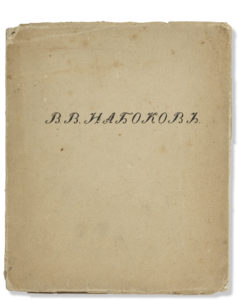The Nabokoviana auction at Christie’s on June 13 is off. All items have been withdrawn.
“A private collector” has preempted the sale by scooping up all 111 lots for “500,000 pounds higher than the overall estimate for all lots”, whatever that might exactly mean, according to “World News – Russian opinion”, an English language website located in the Russian Federation.
My speculation is that a Russian oligarch, for reasons of pride, patriotism, and prestige, approached Christie’s or DM and began negotiating. If I understand the one news report, the buyout is £500,000 over the high estimates of the 111 lots. Is the 25% commission in the original book costs with the £500K added on? Or does Christie’s get its 25% out of the £500K. I can imagine other ways of calculating who gets what.
The high estimates of the 111 lots adds up to £187,200. Christie’s premium, in a standard auction situation, would then be £46,800, for a total of £234,000 ($384,663 at the 6 June exchange rate). So this mysterious oligarch is paying either £687,200 (more likely) or £734,000. So the least being paid is probably $1,127,548. That’s £6191 per item. The average pre-auction high estimate is £1686 per item.
Conclusions: Signed, inscribed, lepted, or whatever VN items just became more dear. By a lot. Dealers won’t be offering any of those books because they will end up in a museum/library or the private stash of a probably very private person. The deal implies high four-/low five-figure valuations on special VN items.
One thing I don’t understand. It is now 11pm on Tuesday. This deal was revealed early this morning, around 5:30am. Why no Google hits, other than the one? (Bing/Yahoo didn’t pick it up at all.)
Another point: I wonder why this Russian oligarch, or whomever he/she is, didn’t buy the Laura manuscript at the end of last year. Maybe because it was in English.


Recent Comments